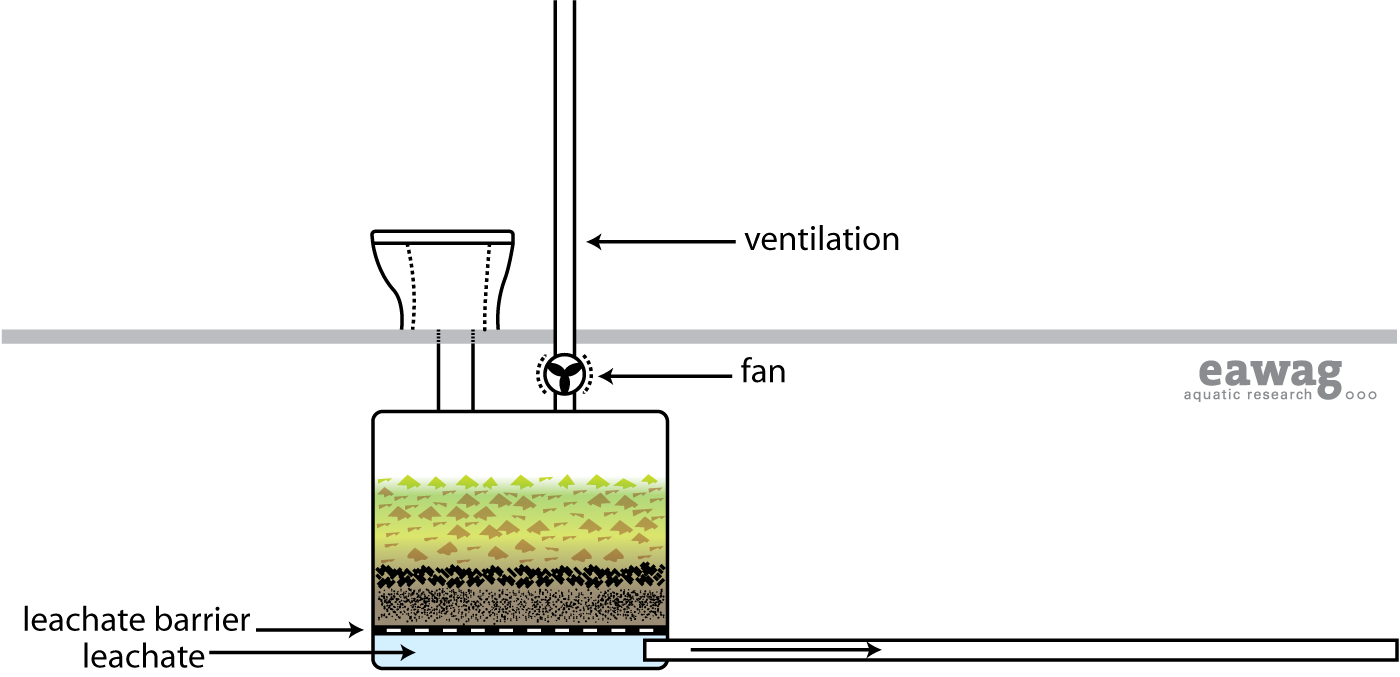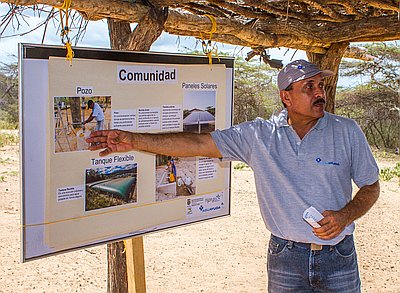Difference between revisions of "Composting Chamber"
(→Field experiences) |
(→Field experiences) |
||
| Line 77: | Line 77: | ||
===Field experiences=== | ===Field experiences=== | ||
| − | {|style="width: | + | {|style="width: 70%; text-align: justify; background-color: #f5f5f5;" |
|[[Image:rsr 789.jpg|thumb|none|200px|<font size="2"><center>Project 789</center></font>|link=http://rsr.akvo.org/project/789/]] | |[[Image:rsr 789.jpg|thumb|none|200px|<font size="2"><center>Project 789</center></font>|link=http://rsr.akvo.org/project/789/]] | ||
|'''Akvo RSR Project:''' [http://rsr.akvo.org/project/789/ MWA-LAP: Colombia] | |'''Akvo RSR Project:''' [http://rsr.akvo.org/project/789/ MWA-LAP: Colombia] | ||
Revision as of 04:24, 17 October 2013
|
|||||||||||||||||||||||||||
Composting refers to the process by which biodegradable components are biologically decomposed under aerobic conditions by microorganisms (mainly bacteria and fungi). A Composting Chamber converts excreta and organics into Compost. Compost is a stable, inoffensive product that can be handled safely and used as a soil conditioner.
This technology usually requires four main parts:
- a reactor (storage chamber);
- a ventilation unit to provide oxygen and allow gases (CO2, water vapour) to escape;
- a leachate collection system ; and
- an access door to remove the mature product.
A Composting Chamber can be designed in various configurations and constructed above or below ground. UDDT can be used as a User Interface for specifically designed Composting Chambers. Anal Cleansing Water should not be added to the composting chamber as it could cause anaerobic conditions, foul smells and reduced collection capacity.
There are four factors that will ensure the good functioning of the system:
- sufficient air (oxygen), provided by active aeration (pumped air) or passive aeration;
- proper moisture (ideally moisture content should be between 45–70%);
- internal (heap) temperature of 40–50°C (can be controlled with proper chamber dimensioning); and
- a 25:1 carbon to nitrogen ratio (theoretically) which can be adjusted by adding an external source of carbon such as toilet paper, wood chips, and/or vegetable scraps.
It is appropriate to assume a design value of 300L/person/ year to calculate the required chamber volume.
| Advantages | Disadvantages/limitations |
|---|---|
| - The compost that is removed is safe to handle and can be used as a soil conditioner. - Can help reduce the volume of solid waste generated by diverting organic material into the composting unit. - Can be built and repaired with locally available materials - Long service life. - No real problems with flies or odours if used correctly. - Low-moderate capital costs depending on emptying; low operating costs. - High reduction of pathogens. - Does not require constant source of water. |
- Leachate requires secondary treatment and/or appropriate discharge. - Requires expert design and construction supervision. - May require some specialized parts - May require long start up time. |
Contents
Adequacy
Although simple in theory, Composting Chambers are not always easy to operate. The moisture must be controlled to prevent anaerobic conditions, the ratio of carbon and nitrogen must be well balanced and the volume of the unit must be such that the temperature of the compost pile remains between 40 to 50°C. However, once the composting process is well established, the system is quite robust.
Depending on the design, Composting Chambers can be used indoors with the comfort and convenience of a flush toilet.
This technology is appropriate to almost all areas, but since it is compact and waterless, it is especially suited to warm climates and to areas where land and water are limited. In colder climates, a Composting Chamber can also be used indoors to ensure that low temperatures do not impede the composting process. A Composting Chamber cannot be used for the Collection and Storage/ Treatment of anal cleansing water or greywater; if the reactor becomes too wet, anaerobic conditions will form and there will be problems with odour and improper degradation.
Health Aspects/Acceptance
If the Composting Chamber is well designed and constructed, there should be no reason for the users to handle the material for at least the first year, and thus, little opportunity to come in contact with pathogens. A well functioning Composting Chamber should not produce odours, and should be easy to maintain. If there is ample cover/bulking material there should not be problems with flies or insects.
Upgrading
A simple Composting Chamber can be upgraded to include a small ventilation fan, a mechanical mixer, or multiple compartments to allow for increased storage and degradation time.
Maintenance
Depending on the design, the Composting Chamber should be emptied every 2 to 10 years. Only the completely mature compost should be removed. With time, salt or other solids may build up in the tank or in the leachate-collecting system, which can be dissolved with hot water and/or scraped out. A squeeze test can be used to check the moisture level within the Composting Chamber. A squeeze test requires the user to squeeze a handful of compost. The compost should not crumble and feel dry, nor should it feel like a wet sponge. Rather, the compost should only leave a few drops of water in the user’s hand.
Field experiences
| Akvo RSR Project: MWA-LAP: Colombia
Positively impact 8,000 people in La Guajira, Colombia by:
|
| Akvo RSR Project: WaSH program in Rural Bangladesh
Considering the unhealthy and unhygenic environment in rural school and community in southern part of Bangladesh, PSTC will initiate WaSH for schools and communities. lt ensures drinking water and sanitation both in school and community by installing hardware in selected school and areas. In addition, hygiene promotion is done through group meeting/courtyard meeting in school and community. |
References
- Del Porto, D. and Steinfeld, C. (1999). The Composting Toilet System Book. A Practical Guide to Choosing, Planning and Maintaining Composting Toilet Systems, a Water-Saving, Pollution-Preventing Alternative. The Center for Ecological Pollution Prevention (CEPP), Concord, Massachusetts. Comprehensive installation and maintenance for pre-fabricated units.
- Drescher, S., Zurbrügg, C., Enayetullah, I. and Singha, MAD. (2006). http://www.eawag.ch/forschung/sandec/gruppen/swm/projects/decentralised_composting/index Decentralised Composting for Cities of Low- and Middle-Income Countries – A User’s Manual]. Eawag/Sandec and Waste Concern, Dhaka.
- Jenkins, J. (1999). The Humanure Handbook-2nd Edition. Jenkins Publishing, Grove City, PA, USA. Theory, history, and do-it-yourself guide to composting toilets.
- USEPA (1999). Water Efficiency Technology Fact Sheet: Composting Toilets- EPA 832-F-99-066. US Environmental Protection Agency, Washington. Information related to microbial die off rates and risks.
Acknowledgements
The material on this page was adapted from:
Elizabeth Tilley, Lukas Ulrich, Christoph Lüthi, Philippe Reymond and Christian Zurbrügg (2014). Compendium of Sanitation Systems and Technologies, published by Sandec, the Department of Water and Sanitation in Developing Countries of Eawag, the Swiss Federal Institute of Aquatic Science and Technology, Dübendorf, Switzerland.
The 2nd edition publication is available in English. French and Spanish are yet to come.




